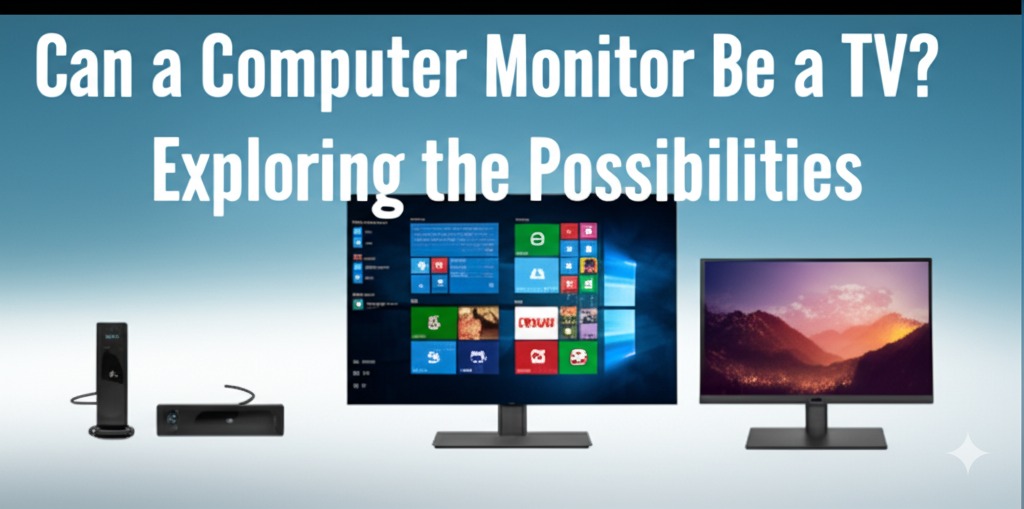In today’s fast-paced world, where technology is constantly evolving, the line between different types of screens is becoming increasingly blurred. Many people wonder if they can use a computer monitor as a TV to save money or to reduce clutter in their living spaces. After all, both devices share similar features and functionality. But can a computer monitor really replace a TV? In this article, we’ll delve into the nuances of using a computer monitor as a TV, exploring the differences, limitations, and benefits of this approach.
Understanding the Differences: Computer Monitor vs. TV
Before we explore the idea of using a computer monitor as a TV, it’s essential to understand the key differences between the two devices.
1. Display Technology
Both monitors and TVs use similar display technologies such as LCD, LED, and OLED. However, TVs are often designed with larger screen sizes and are optimized for viewing from a distance. Monitors, on the other hand, are generally designed for closer viewing and are usually smaller.
2. Connectivity
A significant difference lies in the ports and connectivity options. TVs typically come with HDMI ports, cable inputs, and sometimes even Wi-Fi and Ethernet ports for streaming. Most monitors primarily offer HDMI or DisplayPort inputs, which can work with certain devices, but TV tuners (for over-the-air channels) are usually absent in monitors.
3. Audio Quality
While TVs often come with built-in speakers that provide decent sound quality, monitors tend to lack integrated speakers, or their speakers may not deliver the same sound quality as those of a TV. As a result, if you plan to use a computer monitor as a TV, you may need an external speaker system or soundbar.
Can a Computer Monitor Be Used as a TV?
Yes, a computer monitor can be used as a TV with the right equipment and setup. However, it’s not always as straightforward as simply plugging in a cable. Let’s look at some important factors to consider when trying to turn your monitor into a TV.
1. Connectivity Options
To turn your computer monitor into a TV, you will need to make sure that it has the appropriate input ports. Most modern monitors come with at least one HDMI port, which is a primary connection for many TVs, cable boxes, and streaming devices. If your monitor lacks an HDMI port, you can still connect a TV tuner box or streaming device through other methods like VGA to HDMI converters.
2. Using Streaming Devices
One of the easiest ways to use a computer monitor as a TV is by connecting a streaming device like a Roku, Amazon Fire Stick, or Apple TV. These devices connect via HDMI and allow you to stream content from services like Netflix, Hulu, and YouTube. While this method won’t give you access to traditional TV channels, it provides a wide variety of entertainment.
3. TV Tuner Boxes
For traditional television channels, you’ll need a TV tuner box. This device picks up over-the-air signals and lets you watch live TV on your monitor. TV tuners come in USB, HDMI, and other forms, so it’s essential to choose one that’s compatible with your monitor. Some models even come with their own remote control, making it a more TV-like experience.
4. Using a Computer as a TV Source
If your monitor is connected to a computer, you can easily stream TV shows, movies, and live broadcasts through online platforms. Applications like Plex or Windows Media Center allow you to turn your computer into a media hub. Pairing this setup with streaming services or a cable subscription through your computer can give you the full TV experience.
Audio Considerations
One major drawback when using a computer monitor as a TV is the sound quality. Many monitors have poor built-in speakers or lack speakers altogether. This can make watching TV shows or movies less enjoyable. To resolve this issue, you may want to invest in external speakers or a soundbar. Many monitors support audio output via HDMI, so connecting a sound system is relatively simple.
Advantages of Using a Monitor as a TV
While there are some drawbacks, there are several benefits to using a computer monitor as a TV.
1. Space-Saving
If you’re tight on space, a computer monitor might be a more compact solution compared to a large, bulky TV. Whether it’s in a dorm room, small apartment, or office, a monitor can serve dual purposes, reducing the need for multiple devices.
2. Cost-Effective
In many cases, a high-quality monitor may cost less than a TV with similar specifications. If you already own a computer monitor, adding a streaming device or TV tuner can turn it into a TV without spending a lot of extra money.
3. Multi-Functionality
A computer monitor offers more versatility than a TV. It can be used for gaming, work, and other computer-related tasks, all while serving as a TV for entertainment during your downtime.
Limitations of Using a Monitor as a TV
Although using a computer monitor as a TV can be beneficial in some situations, it’s not always the perfect solution. There are some limitations to keep in mind:
1. No Built-in TV Tuner
Without a built-in TV tuner, you’ll need an external device (like a TV tuner box or streaming device) to access live TV. This extra device can add to the cost and complexity of the setup.
2. Viewing Distance
Monitors are typically designed for close-up viewing, whereas TVs are optimized for watching from a distance. If you’re sitting far from the monitor, the viewing experience may not be as comfortable.
3. Audio Quality
As mentioned earlier, the lack of good built-in speakers is a significant issue for many. You’ll need additional equipment for better sound, which adds to the overall setup.
Conclusion: Is It Worth It?
So, can a computer monitor be a TV? Yes, but with caveats. If you already have a monitor and are looking to cut costs or save space, using it as a TV can be a practical solution. However, you’ll need the right accessories, like a TV tuner box or a streaming device, and consider the audio quality issues that may arise. While it may not provide the same seamless experience as a traditional TV, it offers a budget-friendly, versatile option for those who don’t mind a little extra setup.
If you’re thinking about making the switch, start by evaluating your monitor’s connectivity options and whether it’s worth investing in additional devices for a full TV-like experience.

Caleb Carlson is a contributing writer at Computer Site Engineering, specializing in computer technology, software trends, and hardware innovations. His articles simplify complex tech topics, making them accessible to readers of all levels.





